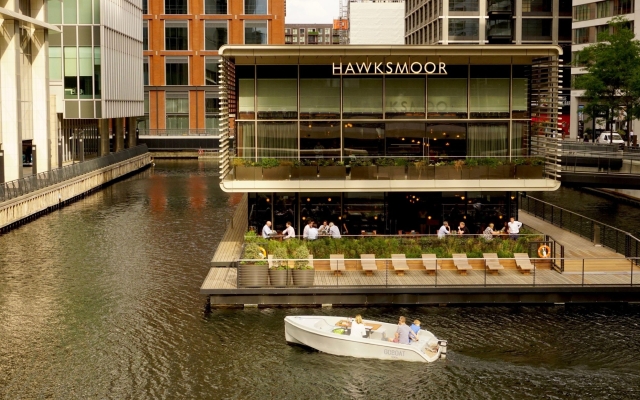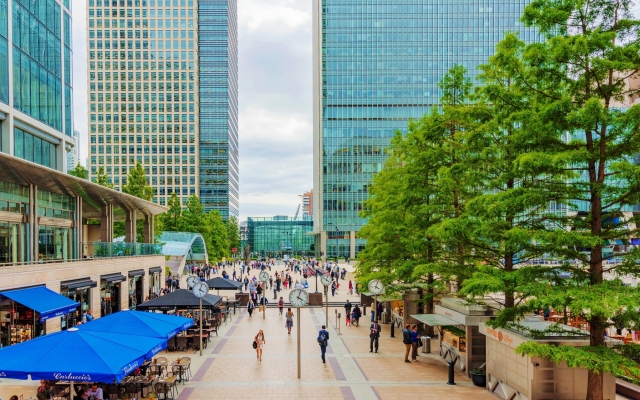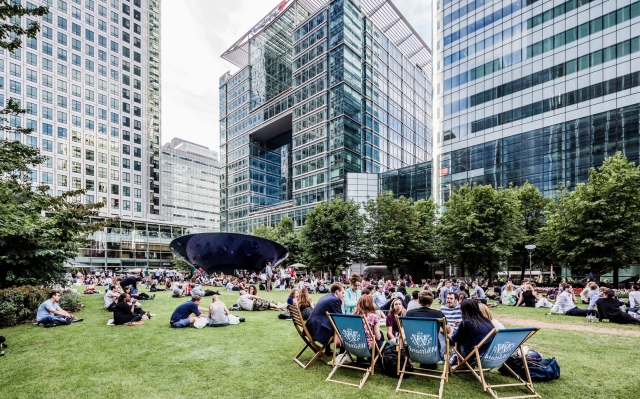
Seated inside a pile driver in East London in May 1988, Margaret Thatcher attempted to operate heavy machinery while wearing her signature skirt suit . , high heels and pearl earrings.
The Iron Lady also wore something less recognizable that day: a hard hat engraved with two words that epitomized the very essence of Thatcher's vision for Britain: Canary Wharf.
Restoring the emaciated London Docks in the late 1980s and early 1990s became a physical symbol of the former prime minister's free market revolution. of the most exciting» projects she's ever known.
 The rebirth of the docks was a symbol of Margaret Thatcher' free market revolution . Photo: PA
The rebirth of the docks was a symbol of Margaret Thatcher' free market revolution . Photo: PA
“Ten years ago it was impossible to even think in such bold and ambitious terms,” she said. “And then things started to happen. First, in 1979 there was a change of government. I think it was a very good change and very wise. Then this government started doing wonderful things.
“We were far-sighted because we knew the spirit of enterprise that Britain was capable of, we believed that it could still be present in our people, and we took risks and planned on the assumption that this was the case.”
Thanks to the liberalization of financial services by the Big Bang government, Canary Wharf has rapidly grown into the UK's second largest financial district, home to some of the world's largest banks, including HSBC, Morgan Stanley and Citigroup.Cocktail . problems
But 35 years after Thatcher's rise to fame, Canary Wharf is facing a host of problems that threaten its future as a financial centre.
The continued popularity of working from home for at least part of the week has prompted global companies to reevaluate their office space needs, making skyscrapers a less attractive proposition than they once were. Perhaps the area's most recognizable resident, HSBC is considering whether to leave Canary Wharf as it shrinks.
Canary Wharf in Numbers
At the same time, the UK zero push is forcing building owners to incur huge costs to bring back old skyscrapers. in line with the new green standards. In some cases, owners have to pay millions to remove old gas systems and replace them with heat pumps.
This leaves Canary Wharf and its residents in the unenviable position of higher costs and threatening revenues.
Last month, credit agency Moody's downgraded Canary Wharf Group (CWG) to junk due to a «challenging operating and financial environment».
To address these challenges, Shobi Khan, Executive Director of the CWG, is trying to shift the group's focus from office buildings to residential and retail real estate, aiming to turn the area into a leading global center for life sciences. It is hoped that bringing in this fresh blood will boost Canary Wharf's appeal and help fund its zero net income major renovation.
But as a number of banks and law firms prepare to say goodbye to Canary Wharf, London's financial center is facing challenges. race against time to reinvent yourself. Will it succeed?
«Personally, I'll go crazy»
Canary Wharf takes its name from the pier where fruits and vegetables from the Canary Islands were once unloaded. The development was created by Canadian real estate mogul Paul Reichmann and his company Olympia & York.
Construction began in 1988 after Environment Minister Thatcher Michael Heseltine founded the Docklands Development Corporation a few years ago.
Despite fierce resistance from local residents, Canary Wharf's first skyscraper, One Canada Square, rose from the docks in 1990. However, it wasn't to everyone's taste at the time, with the then Prince Charles commenting, «Personally, I would go crazy if I had to work in a place like this.»
 Canary Wharf's first skyscraper, One Canada Square, was not to the taste of Prince Charles. Photo: Mike Kemp/In Pictures
Canary Wharf's first skyscraper, One Canada Square, was not to the taste of Prince Charles. Photo: Mike Kemp/In Pictures
Despite the lack of royal approval, businesses continued to flock to the refurbished area. However, despite its early popularity, the project soon ran into financial difficulties.
Canary Wharf went bankrupt in the 1992 real estate crash when Reichmann brought together a consortium of wealthy investors, including the Saudi royal family, to buy it out of the banks. They listed the company on the London Stock Exchange in 1999 and went private in 2015 thanks to Canadian investment manager Brookfield and the Qatar State Wealth Fund in a £2.6bn deal.
After taking over the prospect of a larger parts of the UK commercial real estate sector have changed markedly. Demand for office buildings is declining and the inflationary environment is putting more pressure on companies' finances as debt service costs rise.
A recent Schroders report showed that UK commercial property values fell by more than a fifth place between June 2022 and March of this year — the sharpest correction since the period immediately after the collapse of Lehman Brothers in 2008.
The recession begins
Canary Wharf has become a symbol of the recent downturn in the global real estate market. Moody's decision to downgrade its credit rating even further to trash territory comes as it pays off £1.4bn of debt due in 2024 and 2025.
The ratings agency has warned that Canary Wharf Group may have to unload buildings and ask shareholders for additional capital to refinance and pay off its debts.
Rapidly rising interest rates have hit UK commercial property hard, pushing up borrowing costs for landlords and lowering the cost of their buildings. The higher interest rate situation has coincided with banks restricting lending, which could result in funding constraints for homeowners who will soon need to refinance their debt.
In May, Moody's downgraded Canary Wharf's credit rating further into trash territory. David Scott, head of UK investment research at in real estate at FTSE 100 listed company Abrdn, says: “Lending to the office sector is becoming increasingly difficult at the moment, and it is incredibly difficult to find credit.”
“Continued stress in the banking sector has tightened lending conditions, and while borrowing is still available, lenders have become more selective and funding costs have risen.”
Robert Walker, Head of UK Property at PwC. , adds: «Real estate is highly leveraged in some cases, so when people need to refinance next year, it certainly won't be easy.»
It is understood that the restructuring industry is keeping a close eye on the CWG in case it encounters any difficulties in meeting its debt obligations.
During the pandemic, the company was forced to negotiate a waiver of covenants for its retail and construction loans, while Brookfield wrote off its $231 million (£184 million) stake in the company last year.
CWG's Khan does not appear to be thrilled by Moody's downgrade and says the company has a £130m undrawn line of credit. . He says: “I think we are well capitalized. We have cash on hand and well-leased assets.”
He argues that the downgrade reflects the broader market environment and says people tend to look at commercial real estate from a “broad perspective.”< /p>
He adds: “You have to look not only at the location, but also at the quality of the asset. As real estate goes through these cycles, what always happens is that quality wins. People gravitate towards the best assets, and the best assets hold their value, and that's what we own.»
Shortage of workers
For most of three decades, Canary Wharf has been synonymous with finance, but in recent years, international banks are reducing their footprint in London, and since the pandemic struck in 2020, there has been a revolution in the home-based workforce, leaving the once bustling office buildings a shell of their former selves.
A recent survey by real estate agency Knight Frank found that half of the large multinationals plan to reduce office space in the next three years as they adapt to permanent hybrid operation.
Canary Wharf is not insured. One person who has worked at a bank in the area for more than a decade says the area suffers from a shortage of office workers on Mondays and Fridays, like many other parts of London.
However, he adds that the CWG has «rolled out en masse» to expand retail and hospitality offerings in the area. “They changed the idea of what this place is like,” he says. “Before the pandemic, he had a kind of rigid corporate culture and didn’t have much personality. But Covid made it lighter.”
Restaurants have popped up in the area, including a barge-based floating branch of steakhouse chain Hawksmoor, and a go-kart track under the area. Central Cabot Square.
 Canary Wharf is looking to shed the image of a soulless office and attract more restaurants and social facilities. : Taetae/Alamy Stock Photo
Canary Wharf is looking to shed the image of a soulless office and attract more restaurants and social facilities. : Taetae/Alamy Stock Photo
However, while the CWG is trying to diversify the area with office space, financial companies still account for 55% of the group's rental income.
Most companies with a strong presence in the area have also switched to hybrid operation, resulting in lower office attendance compared to pre-pandemic levels. The CWG's own policy is to allow its employees to work from home one day a week.
This change has caused many companies to reevaluate their office space requirements and the needs of their employees in a hybrid work world.
Last year, elite law firm Magic Circle Clifford Chance announced it would be moving its headquarters from Canary Wharf, where it has been since 2003, to the Square Mile when its lease expires in 2028.
HSBC are also considering whether to stay at 8 Canada Square headquarters, dubbed the «Tower of Destiny». Last year, management told staff that «the best future location in London for our global headquarters» is being explored.
Khan says: «We made an offer to HSBC and they're doing their evaluations.»
Revolut, based in Canary Wharf since its founding in 2015, is similarly seeking a new headquarters in London. , while the Credit Suisse building in the area remains in doubt and thousands of jobs are expected to be cut following its takeover by rival UBS.
However, in a vote of confidence in the area, Wall Street giant Citigroup is holding a £100 million three-year renovation of his skyscraper.
However, working from home raises questions about the future and value of office buildings across the UK.
 The CWG wants the environment to be conducive to both work and play. Photo: Stockinasia/Alamy Stock Photo
The CWG wants the environment to be conducive to both work and play. Photo: Stockinasia/Alamy Stock Photo
PwC's Walker says, “The office as an asset class is complex. What does the future of offices look like? This question is difficult to answer as there are very different views on hybrid work.”
Michael Eakins, chief investment officer at FTSE 100-listed pension giant Phoenix, says the uncertainty is causing investors headaches. still high,” he said. speaks. “But the regional satellite complexes are suffering, and that speaks to Canary Wharf, which is not really in the city center.”
He adds: “I don’t put Canary Wharf in that category, but there are growing concerns that many secondary offices may become obsolete.”
Race to reinvent
For Khan, the future of Canary Wharf lies in attracting shoppers, socialites and residents to turn Canary Wharf into a 24/7, seven-day-a-week «city within a city.»
He says: «When we started, we were 100 percent funded and now we re only 55pc financial. We want to involve various industries.
“We don't rent a space, we rent an environment, because that environment will make people want to come to the office. We want to create amenities so that when people come, they are happy to spend time with their colleagues and friends.”
This process began before the COVID-19 pandemic, but Khan is actively implementing a new strategy. seeks to compensate for the reduction in the number of office workers.
The CWG began building its first residential towers in 2015 and expanded east to Wood Wharf. Today, according to the company, more than 3,500 people live on the Canary Wharf estate, where there were none just five years ago. With 2,200 apartments currently built and 2,000 more under construction.
As part of the «Canary Wharf 3.0» project, as Khan calls it, the CWG has invested heavily in amenities to shake off the image of a somewhat soulless environment occupied by imperious glass and steel structures and overworked bankers.
The company recently dedicated part of the docks to open water swimming and is about to open a center for padel, a popular Spanish sport that is a cross between tennis and squash. It is also expanding green space and the boardwalk to provide better access to water.
 Canary Wharf Group is committed to expanding its appeal beyond outside the corporate world. Photo: Corbis Documentary RF
Canary Wharf Group is committed to expanding its appeal beyond outside the corporate world. Photo: Corbis Documentary RF
Despite economic headwinds, Khan remains optimistic about the future of the region. He says: “Over 54 million people passed through our malls last year, the highest number ever. And by May we are already 20% more than this year.
“The Elizabeth line has been a game changer for us, it has been phenomenal and our retail vacancy is less than 3%.”
< p> p>
While financial companies are re-evaluating their loyalty to Canary Wharf, the CWG is trying to convince the British life sciences industry to move to the area. But in doing so, it will have to compete with university strongholds such as Oxford and Cambridge, as well as London's King's Cross.
Credit should be given to Canary Wharf, which has already engaged a number of health agencies such as the Medicines and Health Products Regulatory Agency (MHRA), Genomics England and the NHS Transformation Unit.
Khan says: “We identified in 2019 that life sciences was a great sector and was getting market attention. We are building Europe's largest laboratory building on Severnaya Embankment. It will be 23 floors with 800,000 square feet of laboratory space. We already have a growing UK life sciences ecosystem and see it as an area of growth.»
PwC's Walker thinks this turn makes sense: «If the UK wants to be a leader in the life sciences , it will need to create new campuses. Canary Wharf could be one such hub as questions arise about how some of these office spaces could be refurbished.”
Khan envisions companies moving to the area and their employees living in the area. He says: “As companies seek to attract and retain talent, we can provide housing for them. This way, they don't have to drive to London for work within an hour and a half.
«They can stay in London, enjoy the benefits of living in London and all the culture here, and find themselves in an amazing environment to live in work or play.»
No nightmares
Companies are reevaluating whether they want to work at Wharf as they face the challenge of modernizing buildings to meet new environmental targets. The investment is expected to come with significant additional costs.
Property is on the firing line in the UK's zero-energy drive, with new minimum energy efficiency standards requiring all commercial properties to in the UK had an Energy Performance Certificate (EPC) rated C or higher by April. 2027 and B or better by 2030.
0104 Unlettable London
Investors and analysts say compliance with these rules is a major challenge for the industry as a whole.
Phoenix's Eakins believes many landlords fail to appreciate the costs associated with finishing their buildings up to standard.
“We live in an environment where it is much more difficult to raise finance, and meeting sustainability requirements will require much higher capital expenditures,” he says. “Many companies underestimate the requirements to meet the minimum level. Asset upgrades are an extremely expensive business.”
PwC's Walker agrees. “On top of a number of existing headwinds, huge capital expenditures will be required,” he says.
A Savills report from last year estimated that UK office landlords will collectively spend at least £63bn over the coming years to meet the new energy standards.
Walker adds: “Ten or 20 years ago the industry was a different beast. But property owners now have to zero net emissions by a certain date, and if the buildings they are in are not carbon neutral, they will have no choice but to terminate the lease.”
The CWG owns seven office buildings in the area that are about 30 years old. Khan says, «Now all of our buildings meet government EPC requirements.»
014 Acceptance to central London by class
However, the company will still need to invest heavily to bring some of its buildings up to standards by 2030.
One Canada Square, the building that houses the CWG headquarters, currently has rated EPC C. The CWG stated that compliance by 2030 would require replacing gas-fired boilers with heat pumps in the building to maximize efficiency, and replacing chillers with more modern units.
Meanwhile, Westferry House, which is not owned by the CWG, is currently rated D, highlighting the pressure on other homeowners in the area to comply with the rules as well.
Abbrdn's Scott says sustainability is of «fundamental value» for investors. wants to invest in commercial real estate.
He adds: «It's no longer a 'nice to have', but a 'must have'.» That is why we are seeing a lot of nervousness in regards to secondary and old market segments. Assets should now be best in class when we consider investing.”
There are growing concerns that the costs associated with building retrofits, especially given the current tight credit conditions, could result in some landlords going broke in certain segments of the commercial real estate market.
Scott adds: “We expect there will be sites in the market that will suffer. Office buildings that are not considered best in class may run into trouble.”
In a 1989 speech on the London docks, Thatcher called on the country to embrace the new spirit of enterprise and adventure that she said the Canary Wharf project embodied.
She said: “I think with restructuring, with renewal we have seen in Britain, we must be in the best position to lead Europe at the beginning of the next century to that great position in world affairs which her past deserves, and it is our task to make it worthy by our actions today and in the future.”
In some ways, the CWG's plan to transform Canary Wharf into a vibrant new mini-city rather than a financial hub can be seen as a call to Thatcher's entrepreneurial spirit.
However, with the escalating With economic clouds approaching due dates, migration of financial tenants to other areas, and environmental regulations placing additional costs on landlords, questions remain as to whether Khan and the CWG will be able to achieve their lofty ambitions for Canary Wharf.






















































Свежие комментарии